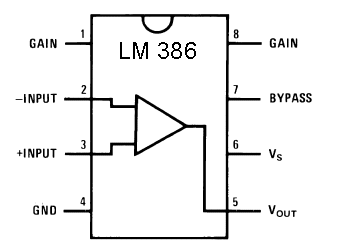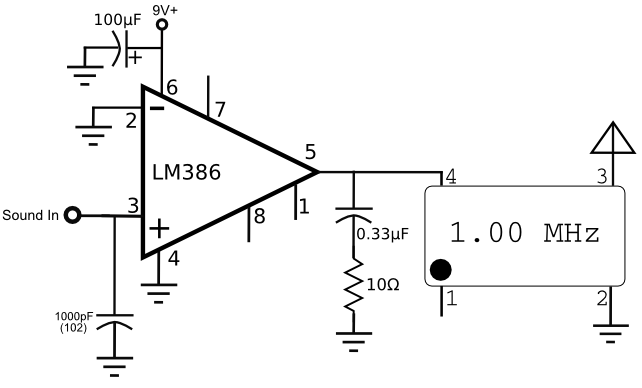The LM386 is a common integrated circuit that acts as an audio amplifier. These little things can actually make some pretty big sound. I've used them in a few projects, like my Arduino doorbell.

Pin diagram for the LM386 IC
The most important pins are 3 (your audio input), 6 (your voltage input), and 5 (your audio output). Pins 2 and 4 go to ground. A capacitor between 1 and 8 will increase your audio gain (a.k.a. louder volume). Pin 7 with a capacitor can be used to clean up the audio output. Checkout the datasheet for more information.
The transmitter circuit feeds the signal output of the LM386 into the crystal oscillator to modulate the RF signal. A few capacitors and a resistor are added to the LM386 as per its datasheet specs and to clean up the audio signal.
If you don't have all the parts for the lm386 portion of the circuit, don't worry. The only part here that really matters is the capacitor on pin 3, which helps increase the audio quality. The capacitor and resistor on pin 5 don't seem to make much of a difference, but I left them in because they are part of the standard lm386 build out from the data sheet. The capacitor on pin 6 where the voltage is input, smooths power fluctuations, but with a 9v battery input you don't need to worry about this too much.
After you power up your circuit and plug it into an audio source (like your phone), tune your radio to 1000 kHz and take a listen. If all went well you should hear music playing, and it should sound a lot better than the circuit in part 2. If the audio is distorted, try lowering the input volume on your phone / mp3 player. The distortion is overmodulation.
Borgata Hotel Casino & Spa - JS Hub
ReplyDeleteBorgata 경상남도 출장마사지 Hotel Casino & Spa has a casino, 안산 출장마사지 poker room, 제주 출장안마 Located 화성 출장안마 near Atlantic City's Boardwalk and Marina District, it features a casino, a 부산광역 출장안마 full